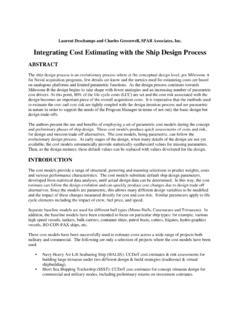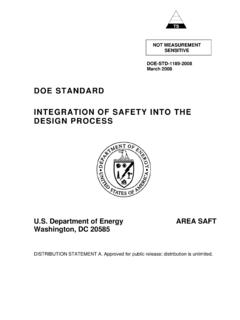Transcription of Electric Vehicle Powertrain Development –Conceptual Design ...
1 International Conference on Automotive and Vehicle Technologies-AVTECH-2013, Y ld z Technical University-Istanbul-Turkey Electric Vehicle Powertrain Development conceptual Design and Implementation Mustafa Karamuk, Mehmet Emin epni, Sedat G r OTAM A. , Automotive Technologies R&D Center, Istanbul-TURKEY Abstract This paper covers various Design aspects of Electric Vehicle Development with main focus on Powertrain system. In the first section of the paper, conceptual Design issues including the types of electrical machines for Electric vehicles are studied and a schematics is proposed as a guideline for Development steps.
2 As part of a national R&D concept, Design activities in an Electric Vehicle project is presented, which covers Development of an interior permanent magnet synchronous machine drive, Vehicle control unit and experimental setup. On-going status in the project, simulation and test results are given. Design and Development Methodology of an Electric Vehicle Introduction The market demand on Electric vehicles is expected to increase in near future. The main obstacles to Electric vehicles are component cost especially high voltage batteries, limited range, and lack of infrastructures of charging stations as well.
3 Main topic of this paper is to present the on-going Design activities in an Electric Vehicle project. The project aims to develop a Vehicle control unit and a drive system for an interior permanent magnet synchronous machine which will be integrated into a prototype Electric Vehicle for public transportation. Specific Design issues are intended to be discussed in a future paper. Process R&D in automotive field is a complex process, where OEM, component suppliers and engineering companies cooperate together. Electric Vehicle technology has differences than conventional vehicles in terms of traction motor, energy source,engineering problems, subcomponents and component suppliers.
4 Therefore, project management of an Electric Vehicle Development has specific issues. To this end, the schematics in figure 1 is proposed as a guideline to define the main Development steps of an Electric Vehicle . As can be seen in the schematics, definition of the Vehicle performance criteria, drive cycles, geography and climate, specifications and component suppliers should be International Conference on Automotive and Vehicle Technologies-AVTECH-2013, Y ld z Technical University-Istanbul-Turkey analysed simultaneously. At the end of this process, four main parameters can be listed as the outputs: Cost Efficiency Weight Range Decision on whether the Vehicle should be a new Design Electric Vehicle or an Electric Vehicle conversion can be based on the assesment of these outputs along with the market segment and annual production volume.
5 Design Steps of an Electric Vehicle *EPAS Steering System: Electric Power Assisted Steering System International Conference on Automotive and Vehicle Technologies-AVTECH-2013, Y ld z Technical University-Istanbul-Turkey It can be concluded that Electric Vehicle conversion is quick and cost effective solution, whereas the Vehicle performance parameters may not be optimal. Design of a new Electric Vehicle provides more flexibility to optimize Vehicle performance parameters and subsystems like weight, range, driveability, NVH (noise-vibration-harshness), regenerative brake , dedicated control algorithm in Vehicle control unit etc.
6 Weight reduction has direct impact on the range of an Electric Vehicle . In [1], impact of the weight on power demand is analysed experimentally. Referring to this analysis, every 200 kg additional weight has kW additional power demand at %15 grade at 30 km/h constant speed. It should be underlined that this result is given for the Vehicle parameters in that experiment. Compared to flat road, impact of weight is increasing at grade because of the additional resistance of gradient sin ( ) in the longitudinal Vehicle dynamics model. In [2], comparison of the weight of the subcomponents of a conventional Vehicle and an Electric Vehicle is given.
7 B. Selection of the Electrical Machine Type One of the important steps in the Design process is the selection of the type of the electrical machine. A brief evaluation is given below. Considering the commercialized Electric vehicles and automotive suppliers, induction machine (IM) and interior permanent magnet synchronous machine (IPMS machine) are the most commonly used electrical machines in Electric vehicles. Main advantages of IPMS machine over IM are the higher efficiency at low speed, high torque/volume ratio and lower weight. In [3] and [4], a comparison of IPMS machine and IM has been made over a city and highway drive cycle.
8 Although these results may change depending on the machine Design and drive cycle profile, it clearly indicates that IPMS machine provides higher efficiency and hence longer range at city cycles. In [4], loss analysis is also given for IM and IPMS machine. Based on this analysis, it can be concluded that energy consumption for cooling of IM is higher than IPMS machine which is another Design issue for energy management and range estimation as well. An analogy for IM and IPMS machine can be made such that IM would be the counterpart of gasoline engine whereas the IPMS would be the counterpart of Diesel engine [1]. In case of IM, trade-off is lower efficiency in city cycle vs.
9 Lower cost for the customer. In case of IPMS machine, trade-off is higher efficiency vs. higher cost for the customer. In the last few years, because of the supply problems of rare-earth elements, cost of IPMS machine is , electrical machines like permanent magnet-assisted synchronous reluctance machine (PMA-SRM), externally excited synchronous machine, and switched reluctance machine are considered as alternative solutions for Electric vehicles. International Conference on Automotive and Vehicle Technologies-AVTECH-2013, Y ld z Technical University-Istanbul-Turkey Externally excited synchronous machines developed by Continental have been applied to Electric Vehicle applications of Renault [5].
10 Design details are given in [6]. PMA-SRM with ferrite type magnets has both magnet torque and reluctance torque component. It is similar to IPMS machine and a cost-effective alternative as well [7-8]. Critical parameters and requirements for the selection of an electrical machine can be listed as follows [1]: Insulation class H Water cooling is required both for electrical machine and inverter. Because the drive cycles, including the increase in ambient temperature, imposes thermal stress on EM and inverter as well. Short term overload capability. The range of peak torque to maximum continuous torque should be to 2.






